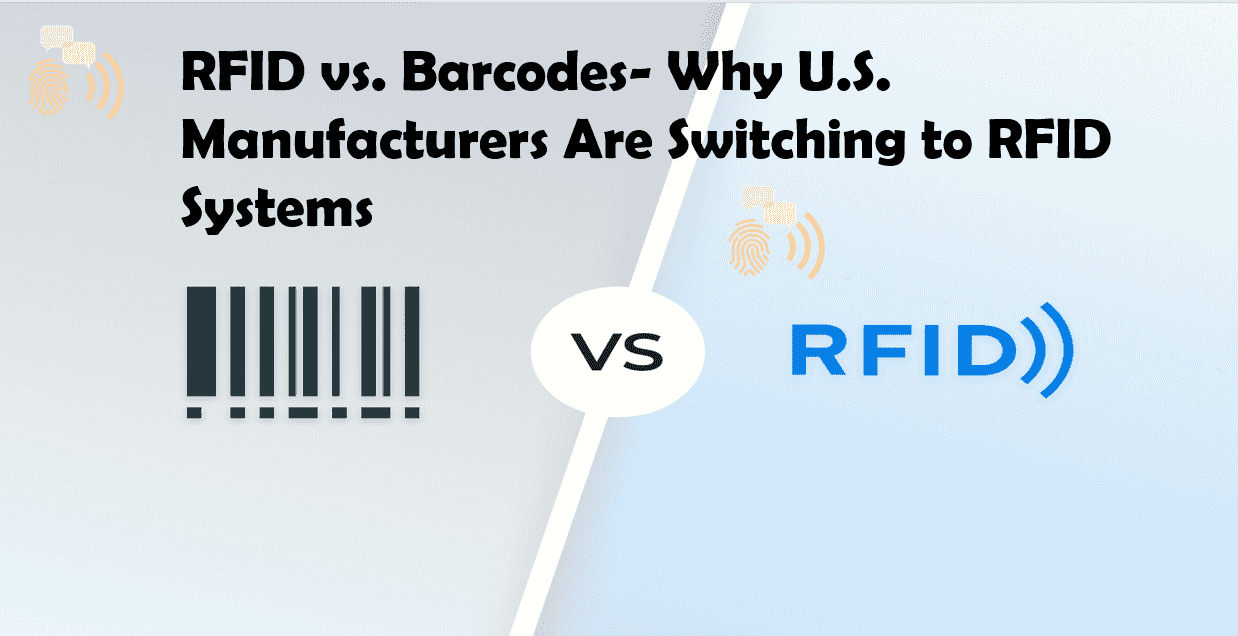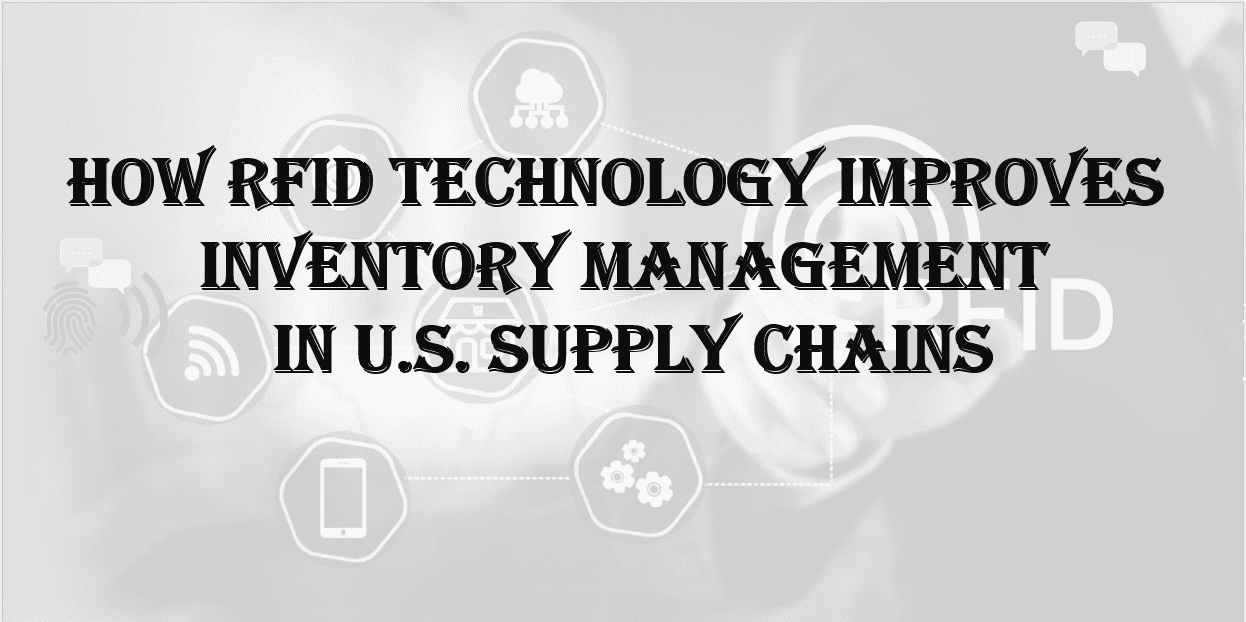RFID vs. Barcodes- Why U.S. Manufacturers Are Switching to RFID Systems

RFID vs. Barcodes: Why U.S. Manufacturers Are Switching to RFID Systems
In recent years, U.S. manufacturers have increasingly made the switch from traditional barcode systems to Radio Frequency Identification (RFID) technology. This change is driven by the numerous advantages that RFID offers over barcodes, such as enhanced efficiency, accuracy, and cost-effectiveness. In this article, we’ll explore the key differences between RFID and barcodes, the reasons manufacturers are adopting RFID systems, and the trends that support this growing shift.
Table of Contents
- What Is RFID and How Does It Compare to Barcodes?
- Advantages of RFID Over Barcodes
- Trends Driving RFID Adoption in U.S. Manufacturing
- Conclusion
What Is RFID and How Does It Compare to Barcodes?
Before diving into the advantages of RFID, it’s essential to understand the basic differences between RFID and barcode systems.
-
Barcodes: Barcodes are a visual representation of data encoded into parallel lines, which can be read by barcode scanners. Barcodes are commonly used to track inventory, shipments, and products within the manufacturing and retail industries. However, barcodes need to be scanned manually, and the scanner must be in line-of-sight with the barcode for it to be read.
-
RFID (Radio Frequency Identification): RFID uses electromagnetic fields to automatically identify and track tags attached to objects. These RFID tags contain small microchips with data, which can be read by RFID readers without the need for direct line-of-sight. RFID tags can store more data than barcodes and can be read from a distance, making them a more versatile option.
While barcodes have been in use for decades, RFID technology has been gaining popularity due to its numerous advantages, particularly in the manufacturing sector.
Advantages of RFID Over Barcodes
-
Improved Efficiency: One of the primary reasons U.S. manufacturers are switching to RFID is its ability to significantly improve operational efficiency. RFID systems can scan multiple tags simultaneously, eliminating the need for manual scanning of individual barcodes. This feature drastically speeds up inventory management, supply chain processes, and quality control, reducing the time and labor needed for tracking products.
-
Greater Accuracy: With barcode scanning, human error is a constant risk, especially if the operator is rushed or distracted. RFID eliminates this issue by automating the data collection process and reducing the likelihood of incorrect data entry. RFID systems also help to minimize errors caused by misplacement of items or misreads of barcodes, ensuring more accurate tracking of inventory and shipments.
-
Longer Range: Unlike barcodes, which require a direct line-of-sight to be read, RFID tags can be read from several feet away, depending on the type of RFID system used. This is particularly useful in large manufacturing plants or warehouses, where products are stored on high shelves or in hard-to-reach places. The ability to track items at a distance without direct contact offers manufacturers significant time savings.
-
Enhanced Security and Data Storage: RFID tags can store more data than traditional barcodes, including product serial numbers, batch numbers, and expiration dates. This allows for more comprehensive tracking of materials, components, and finished products throughout the supply chain. Additionally, RFID tags can be encrypted for added security, helping to prevent theft or tampering.
-
Real-Time Tracking and Visibility: RFID enables real-time tracking of assets and inventory, providing manufacturers with up-to-the-minute data on the location and status of items. This level of visibility is critical for maintaining smooth production schedules and reducing downtime caused by stockouts or misplaced goods. It also allows for better forecasting and demand planning by providing accurate data on inventory levels.
-
Durability and Lifespan: RFID tags are often more durable than barcodes, which can be damaged by wear and tear over time. Since RFID tags are not reliant on print quality, they can withstand harsh environments, including exposure to chemicals, extreme temperatures, and moisture. This makes them ideal for industries like automotive manufacturing or food processing, where durability is key.
Trends Driving RFID Adoption in U.S. Manufacturing
The shift towards RFID technology is not just a trend in isolation but part of broader changes in manufacturing, logistics, and supply chain management. Several key trends are contributing to the growing adoption of RFID systems in U.S. manufacturing:
-
The Push for Industry 4.0: As manufacturers continue to embrace Industry 4.0 technologies, which focus on the integration of automation, data exchange, and real-time monitoring, RFID plays a central role. By enabling seamless communication between machines, sensors, and RFID systems, manufacturers are able to optimize production processes and improve overall efficiency. RFID is an integral part of the “smart factory” concept, where systems can autonomously make decisions based on real-time data.
-
The Rise of E-commerce: The growth of e-commerce and direct-to-consumer models has increased the pressure on manufacturers to ensure rapid and accurate order fulfillment. RFID technology helps improve inventory management, reduce shipping errors, and enhance the customer experience by ensuring that products are in stock and delivered on time. As e-commerce continues to grow, manufacturers are adopting RFID to meet the high standards of speed and accuracy expected by consumers.
-
Cost Reductions: While the initial investment in RFID systems can be significant, the long-term cost savings are undeniable. RFID reduces the need for manual labor in inventory management, improves the accuracy of orders and shipments, and minimizes costly mistakes like lost products or inventory discrepancies. Over time, the reduced labor costs and improved efficiency lead to a positive return on investment.
-
Sustainability and Environmental Benefits: U.S. manufacturers are increasingly focused on sustainability, and RFID can help support these efforts. RFID enables better tracking and management of resources, reducing waste and helping companies optimize production processes. For example, RFID can help manufacturers identify inefficiencies in the supply chain, reduce energy consumption, and improve recycling efforts.
-
Consumer Demand for Transparency: Today’s consumers are more conscious of product sourcing, manufacturing processes, and sustainability. RFID technology enables manufacturers to provide greater transparency to consumers, allowing them to track the journey of a product from raw material to finished good. This level of transparency is not only beneficial for consumers but also helps manufacturers comply with increasingly stringent regulations regarding product sourcing and sustainability.
Conclusion
As the manufacturing landscape continues to evolve, U.S. manufacturers are increasingly adopting RFID systems to improve efficiency, accuracy, and visibility in their operations. RFID offers clear advantages over traditional barcode systems, including real-time tracking, longer read ranges, and more durable tags. The trends supporting this transition—such as Industry 4.0 adoption, e-commerce growth, cost reduction, and sustainability—are helping to drive widespread RFID adoption across the industry. With these numerous benefits and trends in favor of RFID, it’s clear why more U.S. manufacturers are making the switch from barcodes to RFID systems.
For manufacturers looking to stay ahead in a competitive market, embracing RFID technology is not just an option—it’s an essential step toward future-proofing their operations.
Related Products
Here are some key facts and statistics related to RFID adoption in U.S. manufacturing :
1. Growth of RFID Market
- The global RFID market is expected to grow from $13.2 billion in 2023 to $29.5 billion by 2032, reflecting a compound annual growth rate (CAGR) of 9.6% during this period. A significant portion of this growth is driven by adoption in manufacturing, logistics, and supply chain management sectors.
(Source: RFID Journal, MarketsandMarkets)
2. Adoption Rate of RFID in Manufacturing
- According to a 2021 survey by the Automated Identification and Data Capture (AIDC) Institute, approximately 60% of U.S. manufacturers were using RFID technology for some aspects of their operations. The percentage is steadily rising as more companies realize its value in enhancing operational efficiency. (Source: AIDC Institute)
3. Efficiency Gains from RFID
- A study by VDC Research revealed that 80% of RFID adopters saw an improvement in inventory accuracy, with error rates reduced by as much as 30%. RFID allows for real-time tracking and faster data collection, leading to significant efficiency gains in manufacturing and logistics operations.
(Source: VDC Research)
4. Reduction in Labor Costs
- According to a RFID Journal study, manufacturers using RFID systems saw a reduction of 20-30% in labor costs related to inventory management. This is primarily due to RFID's ability to automate the tracking process, which reduces the need for manual data entry and scanning.
(Source: RFID Journal)
5. Real-Time Tracking Impact
- 96% of companies using RFID technology in their supply chain report better inventory visibility and real-time tracking, which significantly improves decision-making and minimizes stockouts or overstocking. This level of visibility is a key factor driving the adoption of RFID in modern manufacturing. (Source: Zebra Technologies, 2020)
6. Cost Savings in Inventory Management
- A 2019 study by Aberdeen Group found that businesses that adopted RFID for inventory management saw an average reduction of 25% in inventory carrying costs and a 50% decrease in stock-outs, which can have a direct impact on operational costs and customer satisfaction.
(Source: Aberdeen Group)
7. RFID in Supply Chain Transparency
- A McKinsey & Company report highlighted that RFID can reduce supply chain lead times by up to 50% and increase order fulfillment accuracy to over 99%, which is crucial for manufacturers focused on reducing delays and improving product delivery timelines. (Source: McKinsey & Company)
8. Environmental Benefits of RFID
- RFID tags are not only more durable but also contribute to environmental sustainability. They help companies reduce waste by optimizing stock management and reducing overproduction. A report from GS1 estimated that RFID could reduce waste in manufacturing and retail supply chains by as much as 5-10%. (Source: GS1)
9. E-commerce and RFID Adoption
- The surge in e-commerce has further accelerated RFID adoption. A report by Zebra Technologies found that 69% of retail and manufacturing companies are investing in RFID to meet the growing demands for fast and accurate e-commerce order fulfillment.
(Source: Zebra Technologies, 2020)
10. Consumer Transparency and RFID
- As consumers demand more transparency in product sourcing, RFID technology is helping manufacturers meet these expectations. A 2022 survey by PwC found that 63% of consumers are willing to pay more for products that are traceable and sustainable. RFID enables greater product transparency, from raw material sourcing to delivery.
(Source: PwC)
These statistics underscore the growing trend of RFID adoption and its significant impact on improving operational efficiency, reducing costs, and enhancing transparency in U.S. manufacturing.





